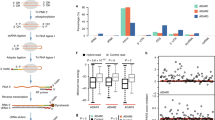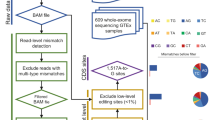Abstract
Adenosine deaminases that act on RNAs (ADARs) interact with double-stranded RNAs, deaminating adenosines to inosines. Previous studies of Caenorhabditis elegans indicated an antagonistic interaction between ADAR and RNAi machineries, with ADAR defects suppressed upon additional knockout of RNAi. This suggests a pool of common RNA substrates capable of engaging both pathways. To define and characterize such substrates, we examined small RNA and mRNA populations of ADAR mutants and identified a distinct set of loci from which RNAi-dependent short RNAs are markedly upregulated. At these same loci, we observed populations of multiply edited transcripts, supporting a specific role for ADARs in preventing access to the RNAi pathway for an extensive population of dsRNAs. Characterization of these loci revealed a substantial overlap with noncoding and intergenic regions, suggesting that the landscape of ADAR targets may extend beyond previously annotated classes of transcripts.
This is a preview of subscription content, access via your institution
Access options
Subscribe to this journal
Receive 12 print issues and online access
$189.00 per year
only $15.75 per issue
Buy this article
- Purchase on Springer Link
- Instant access to full article PDF
Prices may be subject to local taxes which are calculated during checkout







Similar content being viewed by others
References
Werry, T.D., Loiacono, R., Sexton, P.M. & Christopoulos, A. RNA editing of the serotonin 5HT2C receptor and its effects on cell signalling, pharmacology and brain function. Pharmacol. Ther. 119, 7–23 (2008).
Nicholas, A. et al. Age-related gene-specific changes of A-to-I mRNA editing in the human brain. Mech. Ageing Dev. 131, 445–447 (2010).
Burns, C.M. et al. Regulation of serotonin-2C receptor G-protein coupling by RNA editing. Nature 387, 303–308 (1997).
Higuchi, M. et al. Point mutation in an AMPA receptor gene rescues lethality in mice deficient in the RNA-editing enzyme ADAR2. Nature 406, 78–81 (2000).
Rula, E.Y. & Emeson, R.B. Mouse models to elucidate the functional roles of adenosine-to-inosine editing. Methods Enzymol. 424, 333–367 (2007).
Athanasiadis, A., Rich, A. & Maas, S. Widespread A-to-I RNA editing of Alu-containing mRNAs in the human transcriptome. PLoS Biol. 2, e391 (2004).
Osenberg, S. et al. Alu sequences in undifferentiated human embryonic stem cells display high levels of A-to-I RNA editing. PLoS ONE 5, e11173 (2010).
Li, J.B. et al. Genome-wide identification of human RNA editing sites by parallel DNA capturing and sequencing. Science 324, 1210–1213 (2009).
Levanon, K., Eisenberg, E., Rechavi, G. & Levanon, E.Y. Letter from the editor: Adenosine-to-inosine RNA editing in Alu repeats in the human genome. EMBO Rep. 6, 831–835 (2005).
Levanon, E.Y. et al. Systematic identification of abundant A-to-I editing sites in the human transcriptome. Nat. Biotechnol. 22, 1001–1005 (2004).
Barak, M. et al. Evidence for large diversity in the human transcriptome created by Alu RNA editing. Nucleic Acids Res. 37, 6905–6915 (2009).
Blow, M., Futreal, P.A., Wooster, R. & Stratton, M.R. A survey of RNA editing in human brain. Genome Res. 14, 2379–2387 (2004).
Kim, D.D.Y. et al. Widespread RNA editing of embedded alu elements in the human transcriptome. Genome Res. 14, 1719–1725 (2004).
Paz-Yaacov, N. et al. Adenosine-to-inosine RNA editing shapes transcriptome diversity in primates. Proc. Natl. Acad. Sci. USA 107, 12174–12179 (2010).
St. Laurent, G., Savva, Y.A. & Reenan, R. Enhancing non-coding RNA information content with ADAR editing. Neurosci. Lett. 466, 89–98 (2009).
Kleinberger, Y. & Eisenberg, E. Large-scale analysis of structural, sequence and thermodynamic characteristics of A-to-I RNA editing sites in human Alu repeats. BMC Genomics 11, 453 (2010).
Lehmann, K.A. & Bass, B.L. Double-stranded RNA adenosine deaminases ADAR1 and ADAR2 have overlapping specificities. Biochemistry 39, 12875–12884 (2000).
Zinshteyn, B. & Nishikura, K. Adenosine-to-inosine RNA editing. Wiley Interdiscip. Rev. Syst. Biol. Med. 1, 202–209 (2009).
Chen, L.L. & Carmichael, G.G. Gene regulation by SINES and inosines: biological consequences of A-to-I editing of Alu element inverted repeats. Cell Cycle 7, 3294–3301 (2008).
DeCerbo, J. & Carmichael, G.G. Retention and repression: fates of hyperedited RNAs in the nucleus. Curr. Opin. Cell Biol. 17, 302–308 (2005).
Desterro, J.M.P. et al. Dynamic association of RNA-editing enzymes with the nucleolus. J. Cell Sci. 116, 1805–1818 (2003).
Scadden, D. NEAT way of regulating nuclear export of mRNAs. Mol. Cell 35, 395–396 (2009).
Scadden, A.D.J. The RISC subunit Tudor-SN binds to hyper-edited double-stranded RNA and promotes its cleavage. Nat. Struct. Mol. Biol. 12, 489–496 (2005).
Scadden, A.D.J. Inosine-containing dsRNA binds a stress-granule-like complex and downregulates gene expression in trans. Mol. Cell 28, 491–500 (2007).
Hundley, H.A., Krauchuk, A.A. & Bass, B.L. C. elegans and H. sapiens mRNAs with edited 3′ UTRs are present on polysomes. RNA 14, 2050–2060 (2008).
Jin, Y., Zhang, W. & Li, Q. Origins and evolution of ADAR-mediated RNA editing. IUBMB Life 61, 572–578 (2009).
Hartner, J.C., Walkley, C.R., Lu, J. & Orkin, S.H. ADAR1 is essential for the maintenance of hematopoiesis and suppression of interferon signaling. Nat. Immunol. 10, 109–115 (2009).
Wang, Q., Khillan, J., Gadue, P. & Nishikura, K. Requirement of the RNA editing deaminase ADAR1 gene for embryonic erythropoiesis. Science 290, 1765–1768 (2000).
Wang, Q. et al. Stress-induced apoptosis associated with null mutation of ADAR1 RNA editing deaminase gene. J. Biol. Chem. 279, 4952–4961 (2004).
Hartner, J.C. et al. Liver disintegration in the mouse embryo caused by deficiency in the RNA-editing enzyme ADAR1. J. Biol. Chem. 279, 4894–4902 (2004).
Jepson, J.E. & Reenan, R.A. Unraveling pleiotropic functions of A-To-I RNA editing in Drosophila. Fly (Austin) 4, 154–158 (2010).
Jepson, J.E.C. & Reenan, R.A. Adenosine-to-inosine genetic recoding is required in the adult stage nervous system for coordinated behavior in Drosophila. J. Biol. Chem. 284, 31391–31400 (2009).
Tonkin, L.A. et al. RNA editing by ADARs is important for normal behavior in Caenorhabditis elegans. EMBO J. 21, 6025–6035 (2002).
Sebastiani, P. et al. RNA editing genes associated with extreme old age in humans and with lifespan in C. elegans. PLoS ONE 4, e8210 (2009).
Knight, S.W. & Bass, B.L. The role of RNA editing by ADARs in RNAi. Mol. Cell 10, 809–817 (2002).
Tonkin, L.A. & Bass, B.L. Mutations in RNAi rescue aberrant chemotaxis of ADAR mutants. Science 302, 1725 (2003).
Heale, B.S., Keegan, L.P. & O'Connell, M.A. ADARs have effects beyond RNA editing. Cell Cycle 8, 4011–4012 (2009).
Yang, W. et al. ADAR1 RNA deaminase limits short interfering RNA efficacy in mammalian cells. J. Biol. Chem. 280, 3946–3953 (2005).
Heale, B.S.E. et al. Editing independent effects of ADARs on the miRNA/siRNA pathways. EMBO J. 28, 3145–3156 (2009).
Ensterö, M., Daniel, C., Wahlstedt, H., Major, F.C. & Ohman, M. Recognition and coupling of A-to-I edited sites are determined by the tertiary structure of the RNA. Nucleic Acids Res. 37, 6916–6926 (2009).
Wulff, B.E., Sakurai, M. & Nishikura, K. Elucidating the inosinome: global approaches to adenosine-to-inosine RNA editing. Nat. Rev. Genet. 12, 81–85 (2011).
Hundley, H.A. & Bass, B.L. ADAR editing in double-stranded UTRs and other noncoding RNA sequences. Trends Biochem. Sci. 35, 377–383 (2010).
Nishikura, K. Functions and regulation of RNA editing by ADAR deaminases. Annu. Rev. Biochem. 79, 321–349 (2010).
Gent, J.I. et al. Distinct phases of siRNA synthesis in an endogenous RNAi pathway in C. elegans soma. Mol. Cell 37, 679–689 (2010).
Tabara, H. et al. The rde-1 gene, RNA interference, and transposon silencing in C. elegans. Cell 99, 123–132 (1999).
Tabara, H., Yigit, E., Siomi, H. & Mello, C.C. The dsRNA binding protein RDE-4 interacts with RDE-1, DCR-1, and a DExH-box helicase to direct RNAi in C. elegans. Cell 109, 861–871 (2002).
Parker, G.S., Eckert, D.M. & Bass, B.L. RDE-4 preferentially binds long dsRNA and its dimerization is necessary for cleavage of dsRNA to siRNA. RNA 12, 807–818 (2006).
Steiner, F.A., Okihara, K.L., Hoogstrate, S.W., Sijen, T. & Ketting, R.F. RDE-1 slicer activity is required only for passenger-strand cleavage during RNAi in Caenorhabditis elegans. Nat. Struct. Mol. Biol. 16, 207–211 (2009).
Pare, J.M. & Hobman, T.C. Dicer: structure, function and role in RNA-dependent gene-silencing pathways. in Industrial Enzymes. (eds. Polaina, J. and MacCabe, A.P.) Ch. 24, 421–438 (Springer Netherlands, Dordrecht, 2007).
Nicholson, A.W. Structure, reactivity, and biology of double-stranded RNA. Prog. Nucleic Acid Res. Mol. Biol. 52, 1–65 (1996).
Pak, J. & Fire, A. Distinct populations of primary and secondary effectors during RNAi in C. elegans. Science 315, 241–244 (2007).
Xi, Y. & Li, W. BSMAP: whole genome bisulfite sequence MAPping program. BMC Bioinformatics 10, 232 (2009).
Li, H. & Homer, N. A survey of sequence alignment algorithms for next-generation sequencing. Brief. Bioinform. 11, 473–483 (2010).
Sijen, T. et al. On the role of RNA amplification in dsRNA-triggered gene silencing. Cell 107, 465–476 (2001).
Alder, M.N., Dames, S., Gaudet, J. & Mango, S.E. Gene silencing in Caenorhabditis elegans by transitive RNA interference. RNA 9, 25–32 (2003).
Kent, W.J. et al. The human genome browser at UCSC. Genome Res. 12, 996–1006 (2002).
Lamm, A.T., Stadler, M.R., Zhang, H., Gent, J.I. & Fire, A.Z. Multimodal RNA-seq using single-strand, double-strand, and CircLigase-based capture yields a refined and extended description of the C. elegans transcriptome. Genome Res. 21, 265–275 (2011).
Ewing, B. & Green, P. Base-calling of automated sequencer traces using phred. II. Error probabilities. Genome Res. 8, 186–194 (1998).
Robinson, J.T. et al. Integrative genomics viewer. Nat. Biotechnol. 29, 24–26 (2011).
Acknowledgements
We thank J. Gent, S. Gu, M. Stadler, H. Zhang, K. Artiles, J. Pak, L. Gracey, A. Sidow, Z. Weng, P. Lacroute and P. Parameswaran for help and suggestions; the Caenorhabditis Genetics Center, National Bioresource Project and B. Bass (University of Utah) for strains; Stanford Graduate Fellowship (D.W.), Stanford Dean's Fellowship and Machiah Foundation (A.T.L.); and the US National Institutes of Health (R01GM37706 to A.Z.F.) for support.
Author information
Authors and Affiliations
Contributions
D.W. and A.Z.F. designed experiments and wrote the paper. D.W. prepared samples, created small RNA libraries and analyzed the data. A.T.L. created mRNA libraries and participated in discussions.
Corresponding author
Ethics declarations
Competing interests
The authors declare no competing financial interests.
Supplementary information
Supplementary Text and Figures
Supplementary Figures 1–7 and Supplementary Methods (PDF 6558 kb)
Supplementary Data 1
Sample description (XLS 29 kb)
Supplementary Data 2
ADAR-affected sRNA expression over ARLs (XLS 116 kb)
Supplementary Data 3
Annotation enrichment of ARLs (XLS 24 kb)
Supplementary Data 4
Secondary siRNA expression for all genes (XLS 633 kb)
Supplementary Data 5
Genome-wide annotation of putative A-to-I editing (XLS 559 kb)
Supplementary Data 6
Statistics and raw data from Sanger sequencing (XLSX 72 kb)
Rights and permissions
About this article
Cite this article
Wu, D., Lamm, A. & Fire, A. Competition between ADAR and RNAi pathways for an extensive class of RNA targets. Nat Struct Mol Biol 18, 1094–1101 (2011). https://doi.org/10.1038/nsmb.2129
Received:
Accepted:
Published:
Issue Date:
DOI: https://doi.org/10.1038/nsmb.2129
This article is cited by
-
A-to-I editing of coding and non-coding RNAs by ADARs
Nature Reviews Molecular Cell Biology (2016)
-
Dynamic response of RNA editing to temperature in Drosophila
BMC Biology (2015)
-
VIRGO: visualization of A-to-I RNA editing sites in genomic sequences
BMC Bioinformatics (2013)
-
RNA editing regulates transposon-mediated heterochromatic gene silencing
Nature Communications (2013)
-
Diversifying microRNA sequence and function
Nature Reviews Molecular Cell Biology (2013)



